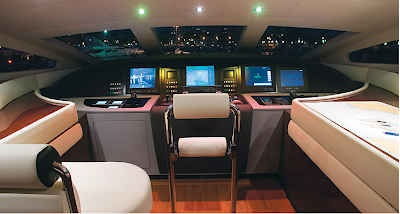

click on the images to enlarge
The ISA 120 really is one of a kind. The sophisticated looking and technologically advanced yacht was built in the 45,000 square foot International Shipyard in Ancona, Italy. It is a streamlined, slim design with 3 decks and spacious, well-designed interiors. The ISA 120 has avant-garde propulsion and stabilization systems, and truly exceptional performance in addition to its stunning looks.

Now three years since its debut, the ISA 120, fiberglass planning yacht is the absolute jewel in the crown of the Ancona shipyard. This is the 9th incarnation of the yacht.

The yacht has exceptional peak speed - 36 knots, for a 120 foot yacht: The engine is a 3 Mtu 16V 2000 M93, each 1790 kW, coupled to 2 KaMeWa hydrojets and 1 central booster makes the boat extremely agile and maneuverable, with quick acceleration, gentle deceleration and turning.

Under the scope of constant innovation, the shipyard has chosen to develop and install the new stabilization system Quantum Zero Speed™ on the latest ISA 120. The active fins react instantly to the demands of the wave movement, contrasting it and reducing rolling during cruising to a minimum, making the yacht very stable also at anchor, thanks to the fact that when the yacht is moored the fins unfold to a wing, thereby increasing the active surface area by one third.

Another important feature is the use of Quantum stabilizers even in speedy cruising. There is no perceivable reduction in speed, as the yacht easily maintains speeds in excess of 33 knots.

There is a balanced ratio of external and internal space: large sea terraces with teak decks, the cockpit and flying-bridge are offset against the enormous light and airy indoor lounge area and the spacious cabins.
click on the images to enlarge
Aft deck and alfresco dining:



Foredeck:

The interiors can be fully customized. The owner’s cabin, for example, laid out on two floors, makes the best possible use of the bow area of the main and lower decks. Below are some shots of the interior.
click on the images to enlarge
Living and lounging areas:


interior dining:


Guest cabins and baths:





Crew cabins:

galley:

The Saloon /Kitchen:


The Master Cabin and bath:






Wanna buy one? Go here to purchase.
Wanna charter one? Go here to do that.
If drooling over mega yachts is your thing, be sure to see this previous post on the Wally Power 118 Superyacht of check out the wild Oculus Yacht here.


































